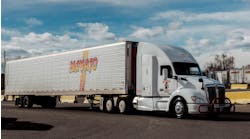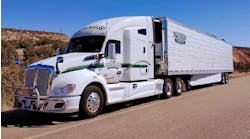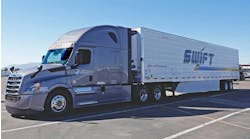The anxiety was overwhelming.
It filled Bay & Bay Transportation owner Sam Anderson with dread every time he closed his eyes, making restful nights impossible.
The stakes were too high, and this was no friendly game of HORSE.
The future of the family business—which the previous owners named after their original, late-1800s cargo delivery power source, two bay mares—and the fate of all its employees, hinged on the success or failure of his 2014 bid to pivot from fielding five diversified over-the-road trucking divisions to one refrigerated trailer fleet, and two years in, the transition wasn’t going well. In fact, it couldn’t have been worse.
For the first time in history, Bay & Bay wasn’t a profitable endeavor in 2017.
“There were a lot of sleepless nights,” Anderson confided. “I would wake up in the middle of the night regularly, trying to figure out how we were going to get through this. And when you’re going through it, it’s the most difficult thing in the world.”
Yet Anderson and his company persevered, going from “hemorrhaging” money four years ago to nearly $200 million in revenue in 2020, despite the COVID-19 pandemic, a sobering SamSam ransomware attack in 2018, and many difficult decisions along the way. And they did it by sticking to the strategic plan, which included investing in their drivers, operationalizing safety principles and practices—which helped them snare a Truckload Carriers Association (TCA) Fleet Safety Award in 2020—and focusing on the ultimate goal: Transforming Eagan, Minnesota-based Bay & Bay into one of the largest refrigerated trucking companies in the United States.
“It was very tough,” Anderson said.
“Thankfully, we have a great team that’s been there through thick and thin, we have great financial partners, who we were very upfront with about what was happening, and we were proactive in what we did—and in identifying what wasn’t working.”
Working together
That, more or less, is how his family ended up in the business.
Anderson’s father, Dave Anderson—a mechanic by trade—wasn’t working after being laid off by Mitchell Transportation, which didn’t survive deregulation. So he and wife Lois, a strong-willed couple who grew up in farming communities in southwest Minnesota, started Anderson Diesel Truck Service in 1982. Their slogan: “Grease is cheaper than repair.”
One of their first customers was Bay & Bay, then owned by the Morse family, who entrusted the Andersons with truck and trailer repairs. One day, having noticed the shop’s new yard tractor—a rebuilt cabover Freightliner the Andersons bought for $5,000—a Bay & Bay dispatcher asked Sam’s dad if he could use the truck to pull one of their pneumatic dry bulkers from Savage to Le Sueur, Minnesota, about an hour away. “So my dad jumped in the truck and went and hooked up the trailer, loaded it, went down and delivered the load, and came back,” Sam said. And the family’s transportation trajectory was set.
By 1986, Bay & Bay—whose owners were nearing retirement and no longer wanted to invest in the company—regularly was contracting with Anderson Diesel, which then had two trucks hauling under Bay & Bay’s operating authority. Two years later, Arnie Morse realized the business no longer worked for him. “He called my dad and said ‘It’s time to throw in the towel, we’ve got a great relationship, you’re already doing 15%-20% of our hauling, so it seems like a good fit. Why don’t you buy the business?’” Sam, now 47, recalled.
Dave agreed, so in 1988 he and Lois purchased the company, which came with seven drivers, eight trucks and 10 trailers. Through steady, conservative growth, they expanded the business to 35 trucks before Sam joined the business in 1998. After he became president in 2006, the company continued to flourish, going from $50 million in revenue in 2005 to $200 million by 2014—when the plan to pivot was hatched.
At that point, Bay & Bay boasted four disparate dry van divisions, including a blanket wrap carrier that hauled industrial equipment for new retail stores and restaurants; a “rolling stock” carrier that delivered vehicles from Polaris, John Deere and Yamaha; a general freight fleet that stocked big box stores like Ashley Furniture and Best Buy—and a refrigerated fleet established after the 2007 acquisition of D&T Trucking.
“We saw some real positives in that refrigerated segment … so we decided we were going to convert 400 of our dry van drivers into reefer drivers,” Sam explained. “And one of the goals in our strategic plan was to become one of the 10 largest refrigerated trucking companies in the U.S.”
With projected 2021 trucking revenue of approximately $220 million—in addition to revenues generated by the company’s multi-modal logistics business that includes a top-50 brokerage—Bay & Bay is on its way. But first it became one of the country’s least profitable reefer fleets in a slide Sam didn’t see coming.
Cold start
Bay & Bay’s 2014 strategic plan originated with an advisory board member’s suggestion that the company hire an outside facilitator to help plot a course for its long-term growth. “We wanted to think about our business, our employees and our customers, and what was going to bring the most value to all of those stakeholders as we move forward and grow; how are we going to be meaningful to the market; and how are we going to protect ourselves through the ups and downs of the economy,” Sam said.
Their burgeoning business blueprint, developed through two days of meetings with the facilitator, a review by Bay & Bay’s advisory board, and more time to tweak the mission, included a collection of core values that would shape all determinations going forward, a focused set of safety principles and practices, and, most importantly, a monumental shift to a unified refrigerated fleet serving the food and beverage industry.
That decision was based on the success of Bay & Bay’s reefer division, which then included 100 drivers and 120 trailers, the more recession-proof nature of moving refrigerated goods—Bay & Bay’s reefer division fared well during the 2008 recession while its other divisions struggled—and the insights Sam gained from participating in a TCA benchmarking program with other reefer carriers.
“When we started telling our refrigerated customers that we were going to buy a lot of refrigerated trailers and start growing the fleet, we had customers lined up to take those spots,” Sam said. “So about mid-year in 2015, I ordered 350 brand new reefer trailers, and we started selling our 600 dry-van trailers.”
Then, in 2016, the economy threw them a curveball.
At the same time the company was selling its old trailers and acquiring new ones, the U.S. entered one of its worst freight recessions, and the refrigerated customers Bay & Bay previously had lined up disappeared. “We were now a refrigerated fleet that wasn’t making money,” Sam said. “And so, for the first time in the history of the company, we didn’t make any money that year, and it was really difficult.
“In fact, from July of 2016 through the end of 2017, was the most difficult time I’ve experienced in business. It was twice as hard as going through the Great Recession, and that was really hard.”
Fleet overlap during the transition was a key factor. It took 18 months to sell all the dry van trailers, burdening Bay & Bay with disproportionate depreciation expenses for the drivers they had on the road. And though they did well selling the trailers, Sam said, they lost $15,000-$20,000 for every truck they unloaded in an unfavorable market while trying to quickly downsize to profitability. “That was a big part of our losses,” he said. “But we needed to reduce our balance sheet so we could get to where we were cash-flow positive.”
The hardest part during that period was letting go of hard-working employees who’d done nothing wrong. Bay & Bay shrunk from about 475 drivers to 250 in five months, Sam said. Finally, in 2017, he hired an investment banker to verify and document the veracity of their new turnaround strategy with Bay & Bay’s primary financing company, Bank of America; and they delivered the plan in June 2017—signifying the start of an upswing. “We have met or beat our plan every quarter except one since then,” Sam said.
Safety essentials
Key to this turnaround—in the midst of a fleet transition—was keeping safety and customer service top of mind.
Bay & Bay’s newly realized vision, which states “Bay & Bay will be the premier provider of surface transportation and logistics solutions for commercial shippers in North America” is centered on a set of core values acronymized as SPIRE:
- Safety—No service is worth having one of our associates or the motoring public hurt
- Positive attitude—Having fun thrilling our customers and coworkers with passion and enthusiasm
- Integrity—The quality or state of being complete; finish well
- Respect—Treating people right
- Excellence—Go above and beyond; doing the little things that make a big difference
In regard to safety, Bay & Bay’s mission is to “set the standard by which other carriers are measured” and go further than DOT compliance by regularly evaluating all team members’ adherence to its Safety Principles:
- We expect everyone to return home safely
- Safety is a way of life at home and at work
- Safety means doing the right thing even when no one is looking
- We will learn and share knowledge to continuously improve safety
- Being safe is a requirement of all team members
Spelling out values and principles, and stating something obvious like “safety’s important” might seem unnecessary, but the results are undeniable. By putting the pledge to paper, and committing to supporting safety with cutting-edge technology, top-notch equipment and award-winning driver coaching, Bay & Bay secured a 2020 TCA Fleet Safety Award with a first-place finish in Division IV (25-49.99 million miles).
“That’s big for us,” safety director Todd Outcelt said. “We’re very excited. This is something that the department here has been striving for as long as I’ve been in this position. We’ve received several awards from the Minnesota Trucking Association … and now we’ve been lucky enough to win the top Minnesota award (in the 5 million Minnesota miles/local miles division of the 2020 Fleet Safety contest), as well as TCA’s top safety award. And it really boils down to communication with the driver, and identifying those behaviors that they don’t really understand.”
Outcelt says its FMCSA Compliance, Safety and Accountability (CSA) scores, as verified by an off-site auditor, have dropped into the single digits in many categories within the last six years, helping many drivers obtain weigh station bypasses. “Our safety scores are really good—beyond satisfactory,” Outcelt said.
Safety investments include advanced drivers assistance systems in new vehicles, a driving simulator from L3Harris Technologies, purchased in 2015, and Lytx DriveCam dash cameras installed in all of the company’s trucks that provide an end-to-end system for measuring the success of drivers and coaches, including David Foster, the company’s award-winning safety manager, who was third in the for-hire trucking category of the 2020 Lytx Coach of the Year Awards.
Foster, who also received an innovation award from Lytx for changes to the training portal he recommended, helps drivers improve by identifying poor driving behaviors in real time, providing in-person reviews and instruction, and grading the driver, and himself, on changes realized through constructive coaching.
“A lot of our safety success has to do with the level of coaching that the drivers are receiving from David,” said Justin Johnson, senior vice president of sales and operations. “He’s up there with the best trainers in the industry.”
Equipping excellence
So is Bay & Bay’s equipment.
The company’s trucking operations have swelled to more than 500 trucks and 900 trailers, of which 95% are refrigerated and 200 are intermodal-ready for loading on railroad flatcars. The trucks are Freightliner Cascadias and Kenworth T680s with 72- and 76-inch sleeper cabs, and the trailers are Great Dane and Utility reefers with Thermo King transport refrigeration units (TRUs). The newest Everest series Great Danes come from Trudell Trailer Sales, and the latest Utility 3000Rs are from North Central Utility.
All new trailers feature Hendrickson suspensions and tire inflation systems, Alcoa aluminum wheels, Michelin tires and Jost landing gear. New Kenworth trucks boast Bendix Wingman Fusion driver-assistance systems and Paccar MX-13 engines, and new Freightliners feature Detroit Assurance safety systems and DD15 engines. All trucks Model Year 2017 and newer are spec’d with automated manual transmissions.
The newest Thermo King TRUs, purchased from Thermo King Sales & Service in St. Paul, Minnesota, are CARB Evergreen-certified, Precedent S-600 single-temp units that comply with California’s clean-air requirements. They also boast Thermo King solar panels that help extend battery life. “Those have made quite a bit of difference with the number of batteries we’ve had to replace, and some of the charging issues we had in the past,” said Todd Johnson, vice president of maintenance.
Additionally, new trailers are equipped with FlowBelow wheel covers and fairings, the TRANSTEX Edge Elite Aero Advantage system, and ORBCOMM tracking, which helps the shop keep tabs on preventative maintenance schedules.
Most of the trailers are owned, but a portion are leased for flexibility. “If you take on a new lane, you can go lease some trailers, put them in the fleet, and run it, and see if everything is going well,” Todd said. “If it is, and it looks like a long-term thing, you can always order trailers and replace your short-term lease stock later.”
Bay & Bay maintains two shops, one in Denton, Texas, with two trailer and four truck bays; and a second in Burnsville, Minnesota, with four trailer and five truck bays. The company looks to trade in trucks at 450,000 miles, and trailers on a seven-year cycle, depending on the market—one factor no one controls.
“We’re just a part of it, so we have to be nimble and swift if we’re going to be one of the best-run trucking companies in the country,” Sam said.
Essential service
Bay & Bay now boasts 500 drivers, including 300 owner-operators, and nearly 700 employees.
Operations are divided into three divisions: Refrigerated trucking, multimodal logistics and specialized services, which includes a fleet of 75 tank trailers. The company serves customers in five distinct areas: A Midwest region, a Texas region, OTR East, OTR West and dedicated fleets assigned to specific customers.
Products carried include proteins, confections, dairy, frozen foods and alcoholic beverages.
Bay & Bay hauls meat for Tyson Foods, which Sam said ships approximately 23,000 temperature-controlled loads per week; candy for Mars Wrigley, which is one of their top-five customers; butter and cheese for Land O’ Lakes and Kraft; and frozen French fries for McCain. The company also provides supply chain services for fast food restaurants like McDonald’s, Chipotle and Chick-Fil-A.
“We like to be diverse, but we also want to be careful because if you don’t know the specific needs of a business, you can get into trouble,” Sam said. “So we want people in our operations, and in our claims and risk management area, to really understand these different categories. To be profitable hauling these different things, you’ve got to know the nuances. If you don’t, you’re probably not going to make a lot of money.”
And when you prove worthy, the opportunities are endless in today’s freight environment.
“Once you prove you can deliver on a promise, there is no shortage of opportunity,” Sam said. “There are a lot fewer trucking companies in the refrigerated market, and more undisciplined businesses in the dry van space, relative to the market, because there are fewer barriers to entry in the dry van space. So when the market is soft, a lot of our competitors in the dry van space make bad business choices and lower rates.
“This doesn’t happen as much in the refrigerated space.”
Still growing
Bay & Bay plans to take advantage by continuing to grow its operations strategically—and not for the sake of growth alone—which Sam says includes disciplined pricing and routing, understanding the key performance indicators (KPIs), and pulling the “weeds,” or unprofitable loads, from the freight-mix garden.
A new terminal is in the works, 250 new reefer trailers (175 from Utility, 75 from Great Dane) are on order, and the company’s looking to grow by 100 drivers this year—an ambitious goal considering the driver shortage exacerbated by the pandemic.
Justin said they’re seeing the same shrinking pool as everyone else, but they’ve held strong and continued to add drivers by pouring money into advertising, including social media and search engines, enlisting a new team of “closers” to ensure leads turn into hires, and creating a pay structure that rewards drivers up front by incorporating service, safety and fuel pay bonuses into their weekly compensation.
“There isn’t a silver bullet when it comes to retention and recruiting,” Justin said. “Everybody’s got their own challenges.
“(But) you’ve got to have the right pay, you’ve got to have good equipment, you’ve got to make sure your brand is getting out there, through marketing, and more and more today you’ve got to have lane generation and consistency in your freight network, so drivers get home more frequently. Drivers want to be home more often, and there are fewer drivers who want to be out 14 days-plus to run over the road.”
And with drivers on board, a solid business plan in place, and steadfast commitment to safe and consistent service, anything’s possible.
“It took a lot to get where we’re at today, but now we’re growing, we’re thriving, we’re back north of $200 million in revenue, and we’re on the path to meeting the goals we established in that strategic plan way back in 2014,” Sam said.
“We think we can double our size and get to half a billion in five to six years.”



